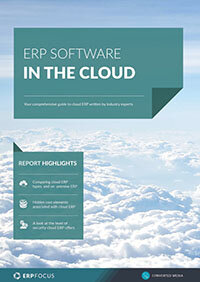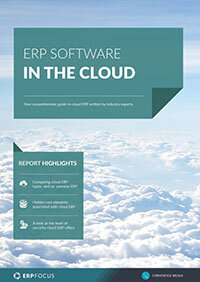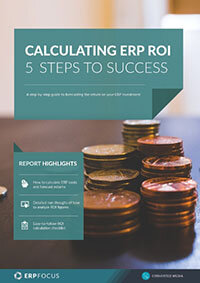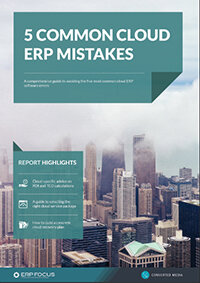ERP Economics: The Fuel to Drive Cloud ERP Growth
ERP and cloud computing have turned out to be hesitant partners. The predicted revolution is still being touted, but most knowledgeable observers understand that the pace of change much more resembles an evolution. It is likely that the evolution will continue, because the advantages to ERP economics continue to accumulate while it becomes increasingly difficult to obtain a good ERP ROI on an internal IT investment (either by increasing productivity or achieving strategic business advantage).
Microsoft points out several interesting economic advantages the cloud has over a traditional hosted-on-site ERP installation in their November, 2010 article, “The Economics of the Cloud”. Because a cloud data center is not tied to any geographic location – like a company headquarters or a manufacturing facility – they can locate wherever power, facilities, and competent labor are cheapest. Cloud data centers can address the traditional problems of having to size capacity to handle demand variability by arranging mixes that tend to dampen variability. The example of having an equal number of European, North American, and Asian customers, for example, ensures that an equal number of transactions are occurring at all hours of the day. Seasonal variability can be dampened by industry combinations; the example is traditionally busy fourth quarter retailers dovetailing with busy first quarter tax preparation firms and busy summer quarter travel industry firms. In addition, large cloud data centers can negotiate lower initial capital investment costs simply by virtue of leveraging their size. These – and other advantages – lead to improved ERP economics in a cloud center operating a state-of the art facility at a significant cost advantage over on-site hosting. In their article “Key Questions Every IT and Business Executive Should Ask about Cloud Computing and ERP”, authors James B. Mattison and Saideep Raj estimate total cost of ownership advantages of 30% to 50% over traditional models.
Why is change occurring so slowly?
There are several factors. One is that the ERP economics are far less favorable for larger firms with significant sunk costs in hardware, licenses, and implementation. As those costs are amortized over time, and as the next money-spending decision arises – for an upgrade, for a product change, for a new module – that is when the economics of the cloud may become compelling. There are other reasons. For some firms, internal customization expertise still provides competitive or productivity advantages. Another concern is the maturity and proven reliability of – fairly new – SaaS ERP solutions. Conservative organizations will wait until there is a longer and more extensive track record of success. This is not unusual; larger firms - especially large heavy manufacturers or process manufacturers - tend to avoid risk by not being early adopters of new technologies such as Cloud ERP. A final hesitancy is the name itself – ERP cloud computing – implying that this all happens by some magic in the sky, an uncomfortable business concept for stolid C-level executives.
It isn’t likely that ERP applications in the cloud will ever be 100%, but it is likely that compelling economics will continue to drive ERP cloud growth.
Free white paper

ERP Software in the Cloud
Get your free guide to cloud ERP software

Featured white papers
-

ERP Software Pricing Guide
Get the latest pricing information on over 80 popular ERP systems, and learn how to budget for your ERP project in our free guide
Download -

Calculating ERP ROI: 5 steps to success
Calculate your new ERP's financial benefits with this comprehensive guide
Download -

Five common cloud ERP mistakes
Get your comprehensive guide to avoiding the five most common cloud ERP errors
Download
Related articles
-
![Three direct links between ERP and manufacturing revenue [image by Snowing on Freepik] Three direct links between ERP and manufacturing revenue [image by Snowing on Freepik]](/pictures/W1siZiIsIjIwMjUvMDEvMjAva2ZwYjAzb3gzX1RocmVlX2RpcmVjdF9saW5rc19iZXR3ZWVuX0VSUF9hbmRfbWFudWZhY3R1cmluZ19yZXZlbnVlX2ltYWdlX2J5X1Nub3dpbmdfb25fRnJlZXBpa18uanBnIl0sWyJwIiwidGh1bWIiLCI0MDB4MjY2IyJdLFsicCIsImVuY29kZSIsImpwZyIsIi1xdWFsaXR5IDg1Il1d/Three%20direct%20links%20between%20ERP%20and%20manufacturing%20revenue%20%5Bimage%20by%20Snowing%20on%20Freepik%5D.jpg?sha=b45b02a140cc8680)
Three direct links between ERP and manufacturing revenue
What you need to know to help you achieve a return on your manufacturing ERP investment
-

CMMC Compliance: What Aerospace and Defense Manufacturers Need to Know
Key insights on CMMC compliance, deadlines, and securing DoD contracts with CMMC 2.0 certificatio...
-
![3 Tips for Achieving Buy-In for Your ERP Integration [by pressfoto on Freepik] 3 Tips for Achieving Buy-In for Your ERP Integration [by pressfoto on Freepik]](/pictures/W1siZiIsIjIwMjQvMTAvMjkvNnQyNmRwdzdwYl8zX1RpcHNfZm9yX0FjaGlldmluZ19CdXlfSW5fZm9yX1lvdXJfRVJQX0ludGVncmF0aW9uX2J5X3ByZXNzZm90b19vbl9GcmVlcGlrXy5qcGciXSxbInAiLCJ0aHVtYiIsIjQwMHgyNjYjIl0sWyJwIiwiZW5jb2RlIiwianBnIiwiLXF1YWxpdHkgODUiXV0/3%20Tips%20for%20Achieving%20Buy-In%20for%20Your%20ERP%20Integration%20%5Bby%20pressfoto%20on%20Freepik%5D.jpg?sha=0e1a55a6cfcac344)
3 tips for achieving buy-in for your ERP integration
Read our expert’s tips on getting your ERP integration project off the ground by achieving busine...

